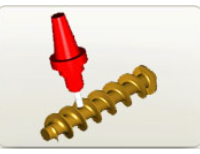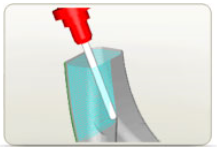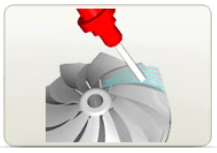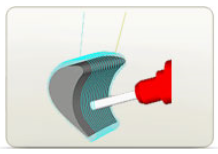5 Axis Machining – Blade/Impeller
Moving the Shop Floor into the Digital Age
September 5, 2019CAMWorks Automates 3 Axis Mold Programming
June 25, 2020CAMWorks 5 Axis Machining Blade/Impeller Machining
CAMWorks 5 axis capabilities
CAMWorks now being popular in small job shops to produce complex part on their 4th and 5th axis machines. Here is an example of a 5 axis blade/impeller machining with the ‘Easy to Use and Powerful Multi-axis CAM Capabilities’. CAMWorks has the workflow supporting a smart manufacturing capabilities with a full suite of advanced multi-axis features. 5 axis simultaneous milling capabilities and advanced turning and mill-turn capabilities are available into a single integrated easy to use system. Thanks to it’s seamless integration with SOLIDWORKS, the design and manufacturing model become one in the same. All of the CAM data is stored directly inside the SOLIDWORKS part and assembly files and the CAMWorks tool-paths update automatically to design changes.
| Machine Complex Parts CAMWorks allows you to take advantage of 4/5-axis machines that provide greater productivity, equipment flexibility and quality. CAMWorks 4/5 axis simultaneous machining programming software allows the user to create tool-paths across complex shapes that could not be machined on 3 axis machines. This includes high-performance automotive port finishing, impellers, turbine blades, cutting tools, 5 axis trimming, and undercut machining in mold and die making. CAMWorks 4 Axis simultaneous machining is designed for complex rotary applications such as camshafts, extrusion screws and blades with benefits including:
Shorter cutting tools can be used since the tool can be tilted to adjust the angle between the cutter and the part. Increased rigidity of shorter tools allows you to take advantage of the high-speed options in CAMWorks to machine at higher speeds with no loss in accuracy. The result is better surface quality and reduced finishing time. Generating 5 Axis swarf tool-paths instead of traditional 3 axis tool-paths can result in fewer cut passes and improved surface finish. CAMWorks multi-axis machining can save time and cut down on mistakes. By optimizing the angle between the tool and the surface, it is possible to achieve a constant chip load and a high feed-rate at the contact point. The result is improved surface finish and extended tool life. Parts that previously required multiple setups can be machined in a single setup with simultaneous control of the rotary axis. In addition to saving time, this also cuts down on mistakes that might be made during multiple setups. |
CAMWorks Multiaxis machining provides a powerful set of features and cutting strategies to meet the machining requirements of diverse applications.
|
 |
|
|  |
 |
|

